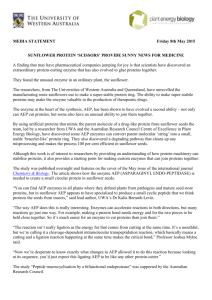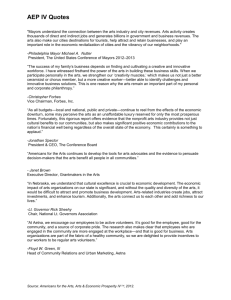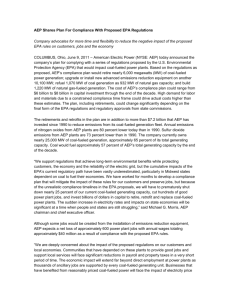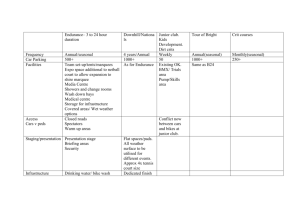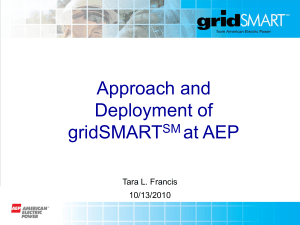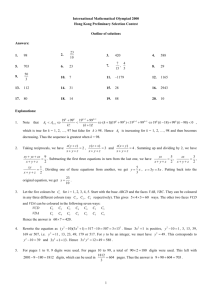Transmission and Related Services
advertisement
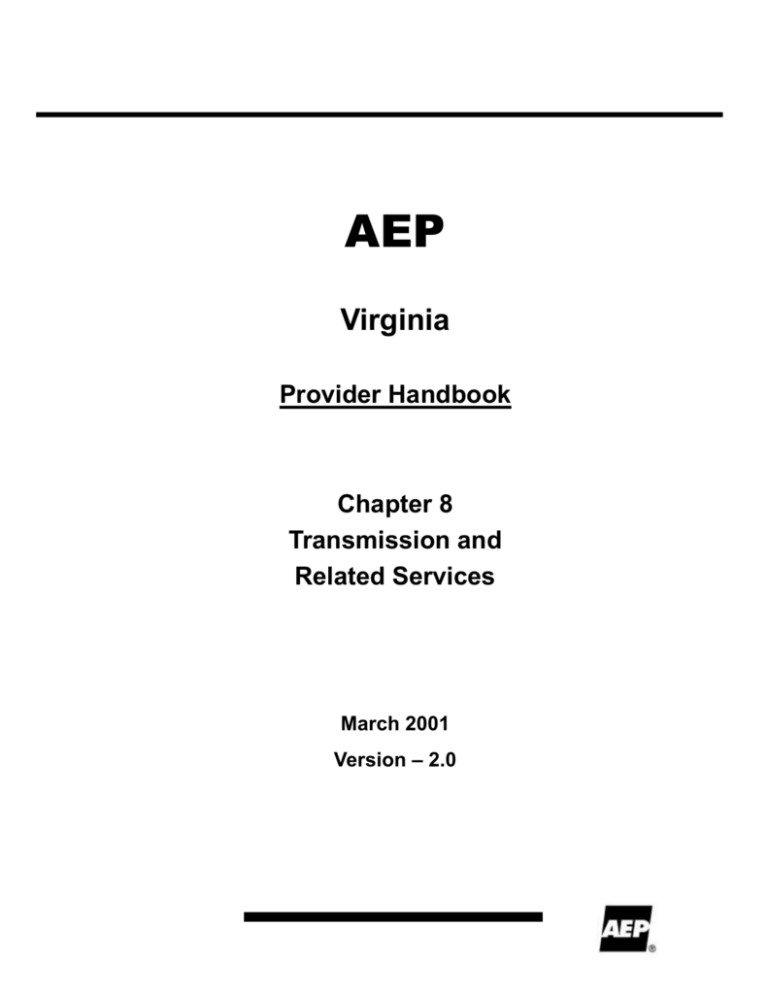
AEP
Virginia
Provider Handbook
Chapter 8
Transmission and
Related Services
March 2001
Version – 2.0
02/17/16
Page 60
8
Provider Handbook
Table of Contents
TRANSMISSION AND RELATED SERVICES ........................................................................................ 62
8.1
INTRODUCTION ............................................................................................................................................. 62
8.2
TRANSMISSION CUSTOMER ELIGIBILITY....................................................................................................... 62
8.2.1
Retail Electric Consumers ................................................................................................................... 62
8.2.2
Energy Service Providers .................................................................................................................... 62
8.2.3
Applying for Transmission Service ...................................................................................................... 63
8.2.4
Initiating Transmission Service ........................................................................................................... 63
8.2.5
NERC Registration .............................................................................................................................. 63
8.2.6
TradeWave Registration ...................................................................................................................... 63
8.2.7
AEP OASIS .......................................................................................................................................... 64
8.2.8
AEP ETAG Access ............................................................................................................................... 64
8.2.9
Miscellaneous Responsibilities ............................................................................................................ 64
8.3
APPLYING FOR TRANSMISSION SERVICE....................................................................................................... 65
8.3.1
Types of Transmission Service ............................................................................................................. 65
8.3.2
Applications ......................................................................................................................................... 65
8.3.3
Deposit Waiver .................................................................................................................................... 66
8.3.4
Creditworthiness .................................................................................................................................. 66
8.3.5
OASIS................................................................................................................................................... 67
8.3.6
Obtaining a Position in Queue ............................................................................................................ 68
8.3.7
Response to Completed Application .................................................................................................... 68
8.3.8
Notice of Deficient Application ............................................................................................................ 69
8.3.9
System Impact Study ............................................................................................................................ 69
8.4
FIRM POINT-TO-POINT TRANSMISSION SERVICE .......................................................................................... 69
8.4.1
Agreement Required ............................................................................................................................ 69
8.4.2
Point-to-Point Service Conditions ....................................................................................................... 69
8.4.3
Initiating Service Pursuant to an Unexecuted Service Agreement ....................................................... 70
8.4.4
Curtailment .......................................................................................................................................... 70
8.5
NETWORK TRANSMISSION SERVICE ............................................................................................................. 71
8.5.1
Agreement Required ............................................................................................................................ 71
8.5.2
Network Service Conditions ................................................................................................................. 72
8.5.3
Description of Network Load Delivery Points ..................................................................................... 72
8.5.4
Amount and Location of Interruptible Network Load .......................................................................... 72
8.5.5
Description of Eligible Customer’s Transmission System ................................................................... 73
8.5.6
Capacity Reservations after the Pilot Program ................................................................................... 73
8.5.7
Rollover Rights .................................................................................................................................... 73
8.5.8
AEP as Default Provider ..................................................................................................................... 73
02/17/16
Page 61
Provider Handbook
Table of Contents
8.6
ANCILLARY SERVICES .................................................................................................................................. 74
8.6.1
Ancillary Schedule 1 – Scheduling, System Control & Dispatch Service ............................................ 74
8.6.2
Ancillary Schedule 2 – Reactive Supply & Voltage Control ................................................................ 74
8.6.3
Ancillary Schedule 3 – Regulation and Frequency Response Service ................................................. 75
8.6.4
Ancillary Schedule 4 – Energy Imbalance Service Overview .............................................................. 75
8.6.5
Ancillary Schedule 5 – Spinning Reserve Service ................................................................................ 76
8.6.6
Ancillary Schedule 6 – Supplemental Reserve Schedule ...................................................................... 77
8.6.7
Settlements ........................................................................................................................................... 77
8.7
LOAD RESEARCH BACKGROUND .................................................................................................................. 77
8.8
CLASS LOAD PROFILES SUPPORTED ............................................................................................................. 78
8.8.1
Load Profile Methodology ................................................................................................................... 79
8.8.2
Load Profile Loss Factors ................................................................................................................... 79
8.9
LOAD PROFILES AND FORECASTS ................................................................................................................. 79
8.9.1
Receiving Load Forecasts .................................................................................................................... 80
8.10
SCHEDULING ENERGY .............................................................................................................................. 80
8.10.1
Energy Scheduling Requirements .................................................................................................... 80
8.10.2
Scheduling for Delivery Losses ........................................................................................................ 81
8.11
BACKCAST PROCESS................................................................................................................................. 82
Provider Handbook
02/17/16
Page 62
Transmission and Related Services
8 TRANSMISSION AND RELATED SERVICES
8.1 Introduction
Eligible retail consumers and Competitive Service Providers (CSPs) participating in the Virginia
Pilot will interact with AEP transmission staff to arrange transmission services and deliver
electricity to loads in the AEP Virginia service area. FERC orders 888 and 889 may be
referenced regarding transmission and related services.
AEP will provide transmission service to transmission customers in accordance with the terms
and conditions of AEP’s Pro Forma Open Access Transmission Tariff (OATT).
This chapter of the Provider Handbook is not intended as a replacement for the OATT.
Transmission customers participating in the Virginia Pilot are expected to become familiar with
the OATT and all applicable provisions.
Pursuant to FERC rules, AEP maintains an Open Access Same-Time Information System
(OASIS) website that provides comprehensive information for doing business under AEP’s
OATT. It is recommended that CSPs use this site as the definitive source of current OATT
provisions and business practices.
This site is located at http://oasis.buyaep.com/OASIS/AEP/
8.2 Transmission Customer Eligibility
8.2.1
Retail Electric Consumers
Residential, commercial, industrial and other retail electric consumers that qualify under any
competitive electric choice program (such as Virginia Pilot Program) are Eligible Customers
under the AEP’s OATT.
Retail electric consumers should be aware that the OATT provides for a 1,000kW (1mW)
minimum transmission billing demand. Licensed and registered ESPs are permitted to combine
the loads of retail consumers under a single application of the OATT.
8.2.2
Energy Service Providers
Utilities and Power Marketers, licensed by FERC to purchase and sell electricity, are Eligible
Customers under the OATT. Parties wishing to obtain Transmission Services in order to sell
Provider Handbook
02/17/16
Page 63
Transmission and Related Services
electric service to consumers in Virginia must be an Eligible Customer and become licensed with
the SCC.
8.2.3
Applying for Transmission Service
Applications for Transmission Service must be completed in accordance with the provisions of
the OATT and sent by fax or email to:
Director-Transmission and Interconnection Services.
Fax: 614-223-2399 or dwbethel@aep.com.
Eligible Customers who apply for transmission service must also demonstrate and maintain
creditworthiness (see 8.3.4), and execute a Service Agreement for Point-to-Point Transmission
Service (OATT Attachment A) or Network Integration Transmission Service (OATT
Attachments F and G). Applications must provide the information, to the extent it is applicable
and known, identified in the Point-to-Point agreement or Section 29.2 (Network) of the OATT.
8.2.4
Initiating Transmission Service
Eligible Customers will obtain transmission and ancillary services from AEP if they have a
pending completed application (valid request) for transmission service or have executed a
transmission service agreement, have demonstrated creditworthiness, and if applicable, become
certified by the SCC. Transmission customers must use the OASIS in making transmission and
ancillary service reservations and network resource designations. All energy delivery schedules
must be submitted using AEP’s electronic tagging (eTag) system. To use these systems, a
transmissions customer (or designated scheduling agent) must register with NERC and
TradeWave. Additional information is available on AEP OASIS home page:
http://oasis.buyaep.com/OASIS/AEP.
8.2.5
NERC Registration
Follow the directions at http://www.tsin.com. Registrants must have a DUNS # and select a
unique identifier (NERC Entity Code).
8.2.6
TradeWave Registration
Register as an OASIS user with TradeWave, AEP’s OASIS node certification authority on the
following website:
Provider Handbook
02/17/16
Page 64
Transmission and Related Services
http://ca1.tradewave.com/oasis.html
8.2.7
AEP OASIS
After obtaining a TradeWave secure OASIS ID and registering with NERC, contact Romelle
Fadis (Phone: 614-413-6626) at AEP’s transmission operation center to request trading rights
access to AEP’s OASIS node. Be prepared to provide the following:
NERC Entity Code (ID)
TradeWave certificate
DUNs #
When a transmission customer makes a request for a Network Resource Designator, a Point-toPoint or ancillary service reservation on AEP’s OASIS node, the queue time will establish the
request approval priority response.
8.2.8
AEP ETAG Access
In order to submit energy schedules, qualified utilities must acquire electronic tagging (eTag)
service from a participating vendor. A list of vendors selling electronic tagging service can be
found on NERC’s website at http://www.nerc.com/~filez/tag/etagvend.html.
All energy schedules must be submitted using eTag by 10:00 a.m. of the day prior to delivery.
Late schedules and changes will be accommodated if practicable, but not later than 20 minutes
before the hour. All eTags must reference a valid OASIS number for a Point-to-Point or
Network Resource reservation.
8.2.9
Miscellaneous Responsibilities
Each Transmission Customer is also responsible for the following:
Paying charges stipulated in Schedules 1-6 of the OATT. Schedules 1 and 2 are mandatory
for all. Schedules 3-6 are optional, but an alternative supply must be comparable.
Identifying all customers served under the Virginia customer choice program by the
applicable monthly deadlines.
Provider Handbook
02/17/16
Page 65
Transmission and Related Services
Arranging for any other transmission service necessary to effect delivery from the generating
source to AEP, prior to service commencement.
Paying for any studies performed or facilities constructed and chargeable to the transmission
customer whether or not the transmission customer takes service for the full term of its
reservation.
8.3 Applying for Transmission Service
8.3.1
Types of Transmission Service
Point-to-Point Transmission Service is for the receipt of capacity and energy at designated
Point(s) of Receipt and delivery of capacity and energy at designated Point(s) of Delivery.
See OATT Parts I and II and Attachment A for the service agreement for Firm Point-to-Point
transmission service and Attachment B for Non-firm service.
Network Transmission Service (NTS) allows the network transmission customer to integrate,
economically dispatch and regulate its network resources to serve its network load in a
manner comparable to that used by an integrated utility to serve its Native load customers.
Pursuant to Sections 30.1 and 30.2 of the OATT, NTS customers may designate qualifying
resources and obtain the highest (FIRM) delivery priority, provided adequate transmission
capacity is available. Other resources may be requested via eTag and, provided transmission
capacity is available, these resources will receive the highest non-firm delivery priority. See
OATT Parts I and III and Attachments F and G for the network service terms and conditions
and agreements.
8.3.2
Applications
An eligible customer requesting service must submit an application, with a deposit
approximating the charge for one month of service or request a waiver of such deposit pursuant
to demonstration of creditworthiness. Applications should be sent to AEP with as much advance
notice as practicable prior to the month in which service is to commence.
Completed applications for transmission service will be assigned a priority according to the date
and time the application is received, with the earliest application receiving the highest priority.
Applications for Point-to-Point Transmission Services must be followed by a reservation request
entered on the transmission provider’s OASIS, once OASIS access is established. Existing
Point-to-Point customers (parties that have previously executed an appropriate service
agreement) may initiate the application process by submission of a request on OASIS. A
Provider Handbook
02/17/16
Page 66
Transmission and Related Services
completed application may be submitted by transmitting the required information to the
transmission provider by email, facsimile, or providing the information by telephone over the
transmission provider’s time recorded telephone line. Each of these methods will provide a timestamped record for establishing the service priority of the application.
Please refer to Parts II and III of the OATT for details regarding applications for Point-to-Point
and Network Integration Transmission Service, respectively.
Applications are to be addressed to:
American Electric Power Service Corporation
Attn: Director – Transmission and Interconnection Services
1 Riverside Plaza
Columbus, OH 43215-2373
8.3.3
Deposit Waiver
AEP may, on a non-discriminatory basis, waive the requirement that a deposit accompany an
application where the eligible customer has established its creditworthiness and is not in default
in its obligations under this tariff at the time of the application. The transmission provider may
bill the eligible customer for any responsible costs incurred by the transmission provider in
connection with its review of the application. Such bill will contain a complete accounting of all
costs included.
The transmission provider shall treat this information consistent with the standards of conduct
contained in Part 37 of the Commission’s regulations.
8.3.4
Creditworthiness
For the purpose of determining the ability of the transmission customer to meet its obligations
related to service hereunder, AEP might require reasonable credit review procedures. See Part I,
Section 11 of the OATT. Creditworthiness will be evaluated initially and periodically thereafter.
Unless otherwise mutually agreed, the transmission customer shall be responsible for providing
Credit Information as specified by AEP. The transmission customer will be considered
creditworthy upon satisfying any of the following conditions, specifically,
a. At the time it enters into a transaction and throughout the term thereof, the transmission
customer provides the transmission provider evidence that its long-term unsecured debt
securities are rated BBB or better by Standard & Poor's Corporation, or Baa2 or better by
Moody's Investor Service, or that its common stock is rated B+ or better by Standard and
Provider Handbook
02/17/16
Page 67
Transmission and Related Services
Poor's Corporation, it being the transmission customer's obligation to notify the
transmission provider of any adverse changes in such ratings.
b. The transmission customer either prepays for service or provides an unconditional letter
of credit for an amount equal to or greater than the total charges for the term of the
transaction. Any letter of credit provided to the transmission provider must be issued by
a commercial bank or financial institution located in the United States or Canada whose
long-term unsecured debt securities are rated A or better by Standard & Poor's
Corporation or A2 or better by Moody's Investor Service, Inc., or comparable rating by
another rating service acceptable to the transmission provider in its sole discretion.
c. The transmission customer has, in the transmission provider's sole discretion, a
satisfactory long-term payment history with any of the AEP operating companies.
d. The transmission provider receives a written guarantee from the transmission customer's
parent company (if applicable) that the parent will be responsible unconditionally for all
financial obligations associated with the transaction, and the transmission customer's
parent company qualifies as creditworthy pursuant to one or more of the provisions of
this section.
e. The transmission customer is a borrower from the Rural Utilities Service and has a Times
Interest Earned Ratio (TIER) of 1.05 or better and a Debt Service Coverage Ratio (DSC)
of 1.00 or better in the most recent calendar year, or an average TIER of 1.05 or better
and average DSC of 1.00 or better achieved in the two best years out of the three most
recent calendar years.
8.3.5
OASIS
OASIS is the vehicle for posting all transmission service transactions. FERC Order 889
mandated the establishment of an electronic information network (OASIS) to serve as the
communication link between buyers and sellers of transmission services. OASIS utilizes the
Internet to provide equal access to transmission information. Some of the information available
on OASIS includes:
User registration
Tariffs (download OATT)
Business practices
Provider Handbook
02/17/16
Page 68
Transmission and Related Services
Contacts, notices, etc.
8.3.6
Obtaining a Position in Queue
No requests for transmission service may be made on OASIS until a transmission customer has
registered with TSIN and TradeWave, and obtained trading rights to AEP’s OASIS node. When
the transmission customer requests Firm Point-to-Point Transmission Service on OASIS, it
serves the dual purpose of satisfying the application requirements (mentioned above) and sets the
queue time for evaluation of the request.
The transmission customer requesting network transmission service can set its queue time by
submitting a completed application for services and/or requesting Network Resource reservations
on AEP’s OASIS. Access to AEP’s OASIS may be obtained at
http://oasis.buyaep/OASIS/AEP/.
8.3.7
Response to Completed Application
NETWORK TRANSMISSION SERVICE
AEP (transmission provider) must acknowledge a complete application for network transmission
service within ten (10) days of receipt. This acknowledgement will include a date by which a
response, and a Service Agreement, will be sent to the eligible customer.
When AEP receives a completed application, it will make a determination of available
transmission capacity to delivery any designated Network Resources to the designated Network
Loads. In the event that sufficient transmission capacity may not be available to accommodate a
request, AEP will respond by performing a system impact study (see 8.3.9).
AEP will inform the eligible customer if it will be able to provide service without performing a
system impact study or if such a study is needed to evaluate the impact of the requested service.
FIRM POINT-TO-POINT TRANSMISSION SERVICE
AEP (transmission provider) shall notify the eligible Firm Point-to-Point Transmission Service
Customer as soon as practical, but no later than 30 days after receipt of a complete application.
The timing of notification must be made on a non-discriminatory basis.
This notification will inform the Firm Point-to-Point transmission customer if it will be provided
service without performing a system impact study (see 8.3.9) or if such a study will be required
to evaluate the impact of the requested service.
Provider Handbook
02/17/16
Page 69
8.3.8
Transmission and Related Services
Notice of Deficient Application
If an application for either Firm Point-to-Point or Network Transmission Service fails to meet the
requirements of the OATT, AEP shall notify the entity requesting service within fifteen (15)
days of receipt of the completed application, noting the reasons for such failure.
AEP will attempt to remedy minor deficiencies in the application through informal
communications with the eligible customer. If such efforts are unsuccessful, AEP shall return the
application, along with any deposit, plus interest. Upon receipt of a new or revised application
that fully complies with the requirements of the OATT, the eligible customer shall be assigned a
new priority consistent with the date of the new or revised application.
8.3.9
System Impact Study
After receiving a request for Firm Point-to-Point or Network Integration Transmission Service,
the transmission provider will determine on a non-discriminatory basis whether a system impact
study is needed. The methodology used by AEP for completing a system impact study is
contained in Attachment D of the OATT.
8.4 Firm Point-to-Point Transmission Service
8.4.1
Agreement Required
A Firm Point-to-Point transmission services customer must execute a Service Agreement of the
form found in OATT Attachment A or request that AEP file an unexecuted agreement with
FERC. Upon receipt of a complete application for service, AEP will tender the appropriate
agreements to the applicant for execution. Transmission service shall be available on a firstcome, first-served basis, in the chronological sequence in which each transmission customer has
reserved service.
If the transmission system becomes oversubscribed, requests for longer term service may
preempt requests for shorter term service up to the following deadline: one month before the
commencement of the monthly service.
8.4.2
Point-to-Point Service Conditions
The terms and conditions of Firm Point-to-Point Transmission Service that are set out in Part II
of the Tariff shall apply to transmission customers taking such service.
Provider Handbook
02/17/16
Page 70
8.4.3
Transmission and Related Services
Initiating Service Pursuant to an Unexecuted Service Agreement
If the transmission provider and the transmission customer requesting Firm Point-to-Point
Transmission Service cannot agree on all of the terms and conditions of the Point-to-Point
Service Agreement, the transmission provider shall file with the Commission, within thirty (30)
days after the date the transmission customer provides written notification directing the
transmission provider to file an unexecuted Point-to-Point Service Agreement containing terms
and conditions deemed appropriate by the transmission provider for such requested transmission
service.
The transmission provider shall commence providing service subject to the transmission
customer agreeing to:
Compensate the transmission provider at whatever rate the Commission ultimately
determines to be just and reasonable
Comply with the terms and conditions of the OATT
8.4.4
Curtailment
CURTAILMENT ON NON-DISCRIMINATORY BASIS
In the event that a curtailment on AEP’s transmission system is required to maintain reliable
operation of the transmission system, curtailments will be made on a non-discriminatory basis to
the transaction(s) that relieve the constraint. All non-firm transactions that impact the constraint
will be interrupted before any firm service is curtailed.
MULTIPLE TRANSACTIONS REQUIRING CURTAILMENT
If multiple transactions require curtailment, the transmission provider will curtail service to
network customers and transmission customers taking Firm Point-to-Point Transmission Service
on a basis comparable to the curtailment of service to the transmission provider’s native load
customers.
EMERGENCY CURTAILMENT
The transmission provider reserves the right to curtail, in whole or in part, any firm transmission
service provided under the OATT when, in the transmission provider’s sole discretion, an
Provider Handbook
02/17/16
Page 71
Transmission and Related Services
emergency or other unforeseen condition impairs or degrades the reliability of its transmission
system.
If AEP determines that an emergency exists on its transmission system and implements
emergency procedures to curtail firm transmission service, the transmission customer shall make
the required reductions upon request of AEP, the transmission provider.
NOTIFICATION OF CURTAILMENT AND PENALTIES
The transmission provider will notify all affected transmission customers in a timely manner of
any scheduled curtailments. If following the transmission provider’s notification of curtailment,
a transmission fails to provide the requested curtailment, pursuant to the OATT and FERC
policies, consequences may be sought by the transmission provider.
8.5 Network Transmission Service
8.5.1
Agreement Required
A network transmission customer must execute a service agreement and/or operating agreement
for Network Integration Transmission Service, or request that the transmission provider file an
unexecuted agreement with the FERC (see 8.4.3). The OATT states that a completed application
for network transmission service shall provide all the following information included in 18 CFR
2.20 including, but not limited to, the following items:
(i.)
The identity, address, telephone number and facsimile number of the party
requesting service.
(ii.)
A statement that the party requesting service is, or will be upon commencement of
service, an eligible retail customer.
(iii.)
A description of the network load to be served.
(iv.)
The amount and location of any interruptible loads included in the network load.
(v.)
A description of network resources for each network load.
(vi.)
Description of the eligible retail customer’s transmission system.
(vii.)
Service commencement date and the term of the requested network transmission
service (minimum term is one year).
Provider Handbook
02/17/16
Page 72
Transmission and Related Services
Note: AEP will waive the requirements of parts (iii.), (iv.), (v.) and (vi.) to the extent such
information is not applicable or, in the case of service requested to serve retail access load, such
information is unknown at the time of application.
8.5.2
Network Service Conditions
The terms and conditions of network transmission service noted in part III of the OATT should
apply:
Service Agreement for Network Transmission Service (OATT Attachments F & G)
Network Operating Agreement
Designed Network Resource Stipulation Form
Any additional forms required by the SCC for licensing or by AEP for registration in the
Pilot Program
8.5.3
Description of Network Load Delivery Points
The description of the network load should:
Separately identify and provide the best estimate of the total loads to be served at each
transmission voltage level
Identify the loads to be served from each transmission provider substation at the same
transmission voltage level
8.5.4
Amount and Location of Interruptible Network Load
If applicable, the amount and location of any interruptible loads included in the network load
should include:
The summer and winter capacity requirements for each interruptible load (had such load not
been interruptible)
That portion of the load subject to interruption
The conditions under which an interruption can be implemented
Any limitations on the amount and frequency of the interruptions
Provider Handbook
02/17/16
Page 73
8.5.5
Transmission and Related Services
Description of Eligible Customer’s Transmission System
A description of an eligible retail customer’s transmission system, if applicable, should include:
Load flows and stability data such as real and reactive parts of the load, lines transformers,
reactive devices and load type, including normal and emergency ratings of all transmission
equipment in a load flow format compatible with that used by the transmission provider.
Operating restrictions needed for reliability and operating guides employed by system
operators.
Contractual restrictions or committed uses of the eligible retail customer’s transmission
system other than the eligible retail customer’s network loads and resources.
Location of network resources.
Transmission system maps that include any proposed expansions or upgrades.
Thermal ratings of eligible retail customer’s control area ties with other control areas.
8.5.6
Capacity Reservations after the Pilot Program
Transmission allocation and reservation capacity during the Pilot Program do not create any
precedent with respect to the availability of transmission capacity for retail customers after the
conclusion of the Pilot Program. All retail customers seeking transmission service after the
conclusion of the Pilot Program will need to reserve transmission capacity as stated in the OATT
and Order No. 888.
8.5.7
Rollover Rights
Rollover rights are available to customers taking service under the Pilot. The provisions of
Section 2.2 of the tariff have been amended to apply to reservations of transmission capacity for
retail.
8.5.8
AEP as Default Provider
If a CSP fails to maintain compliance with AEP’s or SCC’s registration requirements, AEP will
immediately suspend the CSP’s customer enrollment privileges, and may seek FERC approval to
terminate transmission service to the CSP. If the CSP does not correct the non-compliance
promptly, the CSP may be de-registered and retail consumers of the de-registered CSP will
Provider Handbook
02/17/16
Page 74
Transmission and Related Services
receive an AEP standard service offer (bundled) until those consumers choose another CSP.
This action shall in no way relieve the CSP from any contractual obligations.
8.6 Ancillary Services
The procurement of ancillary services is required of a Network Transmission customer to
support reliability within and among the control areas affected by transmission service.
AEP, the transmission provider, is required to provide and the transmission customer is required
to purchase from AEP, the following two ancillary services:
Scheduling, System Control and Dispatch Service
Reactive Supply and Voltage Control from Generation Sources Service
The transmission provider, is required to provide and the transmission customer is required to
purchase the following four ancillary services from AEP, a third party or by self-supply:
Regulation and Frequency Response Service
Energy Imbalance Service
Operating Reserve Spinning and Reserve Service
Operating Reserve Supplemental Reserve Service
Supply of any of these services from a third party or self-supply must be comparable with AEP
supplied ancillary services.
8.6.1
Ancillary Schedule 1 – Scheduling, System Control & Dispatch Service
Ancillary Schedule 1 is required to schedule the movement of power through, out of, within, or
into a control area. The operator of the control area where the transmission facilities are located
can provide this service. The transmission customer must purchase this service from the
transmission provider or the control area operator.
8.6.2
Ancillary Schedule 2 – Reactive Supply & Voltage Control
In order to maintain transmission voltages on AEP’s transmission facilities within acceptable
limits, generation facilities under the control of the control area operator are operated to produce
02/17/16
Page 75
Provider Handbook
Transmission and Related Services
or absorb reactive power. Reactive supply and voltage control from generation sources service
must be provided for each transaction on the transmission provider’s transmission facilities.
Except as necessary to adjust for customer-supplied reactive supply from generators, billing
determinants for a Point-to-Point Transmission Customer are the customer’s reserve capacity and
billing determinants for a Network Transmission Customer are the customer’s network load
calculated as:
Its hourly load (including its designated network load not physically interconnected with the
transmission provider as described in OATT Section 31.3) coincident with the transmission
provider’s monthly transmission system peak.
8.6.3
Ancillary Schedule 3 – Regulation and Frequency Response Service
Regulation and frequency response service is necessary to provide for the continuous balancing
of resources with load and for maintaining scheduled interconnection frequency at 60 cycles per
second (60 HZ). Regulation and frequency response service is accomplished by committing online generation whose output is raised or lowered by automatic controls as necessary to follow
the moment-by-moment changes in load.
Subject to a customer’s exercise of self-supply options or dynamic scheduling, billing
determinants for Point-to-Point Transmission Service customers are 1.00% of the customer’s
reserved capacity. The billing determinants for Network Transmission Service customers are the
1.00% of customer’s network load calculated as described above.
The obligation to maintain this balance between resources and load lies with the transmission
provider. The transmission customer must either purchase this service from the transmission
provider or make alternative comparable arrangements to satisfy its regulatory and frequency
response service obligation.
8.6.4
Ancillary Schedule 4 – Energy Imbalance Service Overview
Energy imbalance service is provided when a difference occurs between the scheduled and actual
delivery of energy to a load located within a control area over a single hour. AEP, the
transmission provider, must offer this service when the transmission service is used to serve load
within its control area, and the customer may not refuse the offer unless it provides for such
service through a compatible alternative.
02/17/16
Page 76
Provider Handbook
Transmission and Related Services
Since the Control Area Operator may only provide Energy Imbalance where a load is metered,
this service may only be provided by AEP or another control area using dynamic scheduling of
the load.
LOADS METERED USING INTERVAL DATA RECORDING (IDR)
Retail access loads measured using Interval Data Recording (IDR) meters that provide actual kW
demands for each hour (customers with maximum demand of 200 kW and above) will be billed
for network transmission service and ancillary services, other than Energy Imbalance Service,
based on their metered demands coincident with the transmission provider’s monthly
transmission peak load plus losses and an allocation of Unaccounted For Energy (UFE).
Charges for Energy Imbalance Service will be derived for such retail consumers based on hourly
differences between scheduled energy receipts and customers’ metered hourly loads (plus losses
and UFE).
LOADS NOT METERED USING INTERVAL DATA RECORDING
For retail consumers whose usage is not measured using IDR meters (not required for customers
with maximum demands less than 200 kW), the transmission provider will calculate billing
determinants by applying a load profile to each retail consumer’s metered usage. A load profile
shall be developed for each customer class based on that class load characteristics. The load
profiles shall be used to determine demands coincident with the transmission provider’s monthly
transmission peak, which shall be the billing determinant for network transmission service and
ancillary services other than Energy Imbalance Service, and to determine hourly usage, which,
together with energy delivery schedules shall be used to calculate energy imbalance settlements.
8.6.5
Ancillary Schedule 5 – Spinning Reserve Service
Spinning reserve service is needed to serve load immediately in the event of a system
contingency. Generating units that are on-line and loaded at less than maximum output may
provide spinning reserve service. AEP, the transmission provider, must offer this service when
the transmission service is used to serve load within its control area.
Subject to a customer’s exercise of self-supply options or dynamic scheduling, billing
determinants for Point-to-Point Transmission Service customers are 1.50% of the customer’s
reserved capacity. The billing determinants for Network Transmission Service customers are the
1.50% of customer’s network load calculated as described above.
Provider Handbook
02/17/16
Page 77
8.6.6
Transmission and Related Services
Ancillary Schedule 6 – Supplemental Reserve Schedule
Supplemental reserve service is needed to serve load in the event of a system contingency.
However, this service is not available immediately to serve load but rather within a short period
of time. Generating units that are on-line, but are unloaded by quick-start generation or by
interruptible load may provide supplemental reserve service.
8.6.7
Settlements
Energy imbalance:
A. Presently AEP uses a Standard FERC Schedule 4 deviation band method that provided
±1.5%, 2 MW minimum, error returned in-kind
Excess under-scheduled energy charged of $100/MWh or 110% incremental cost
Excess over-scheduled energy, i.e., dump energy paid at AEP firm load lambda
B. Beginning January 1, 2001, energy imbalance for retail choice will be settled pursuant to
Sections 4.2 and 4.3 of the new Retail Energy Imbalance Service, Schedule 4A under the
OATT, approved by FERC effective January 1, 2001.
8.7 Load Research Background
AEP’s Load Research group has traditionally maintained on-going samples of the various
customer rate classes to determine their demand characteristics, including how the class demand
relates to AEP’s system and operating companies’ peaks. Historically, AEP has relied on this
information in studies that estimate the costs to provide services to each customer rate class for
ratemaking purposes.
These samples are selected by dividing the class populations into homogeneous groups and
randomly selecting a sample of accounts from each group. Special recording equipment is then
installed on these chosen accounts to record energy consumption by quarter-hour.
To divide the class populations into these groups (called strata) the information known for all
accounts in the class is examined to determine which is most likely to correlate to the class
demand at time of the AEP jurisdiction peak. This information may be the total monthly energy
consumption, the highest registered demand value, monthly or annual load factor, the Standard
Industrial Classification (SIC) code, the revenue code, etc. AEP has generally used 12-month
02/17/16
Page 78
Provider Handbook
Transmission and Related Services
average maximum billing demand for classes in which this value is always recorded and 12month average kWh usage for other classes.
In addition, AEP has installed these special load recorders on all customers that have peak billing
demands in excess of 1700 kW.
Average class load profile information for classes, which will utilize load profiling, will be
posted on AEP’s web site at http://www.aep.com.
The profiles initially provided by AEP will be the 1999 average per customer load profile for
each of the rate classes for which load profiling may be utilized to allocate cumulative energy to
an hourly basis for Pilot participants in the settlement process. These profiles reflect actual
measurements from our load research samples, and thus reflect “aggregate” weather conditions
across AEP’s Virginia service area. These profiles are for informational purposes only and will
not be used to generate forecasted or backcasted aggregated loads for scheduling or settlement
purposes. They do, however, provide an estimate of usage patterns across AEP’s Virginia
service territory, given the weather actually experienced for the period. Current plans are to
update these “static” profiles semi-annually. Specific class load profiles will be selected daily to
most accurately forecast and backcast class loads using “proxy day” selection techniques.
8.8 Class Load Profiles Supported
Load profile information will be made available for the following customer classes:
Residential Service
Small General Service
Medium General Service
Large General Service
Large Power Service
Sanctuary Worship Service
In addition, profiles will be published for photo-controlled dusk to dawn outdoor lighting
service. These profiles are derived based on solar cycles and lamp wattage rather than from
sample metered load research.
Provider Handbook
02/17/16
Page 79
8.8.1
Transmission and Related Services
Load Profile Methodology
Customers with maximum demands below 200 kW do not require interval data recorders to
participate in customer choice and a load profiling technique will be used to generate the CSP’s
forecast, backcast, and final hourly load allocations.
Profiled customers are assigned to a class profile that is scaled based on billing cycle kWh. This
is accomplished by what is known as a usage factor. Every month the customer’s usage factor is
updated based on their available historic usage. When a customer first enrolls with a new CSP,
historic usage is provided to the model so usage factors can be calculated. For the forecasting
and backcasting functions the profile from a similar historical day is used in the CSP hourly load
calculation. For the final settlement calculations, actual metered loads from each time period
will normally be used. In all cases estimates of losses, based on service voltage level, are added
to the metered load profiles.
8.8.2
Load Profile Loss Factors
Line losses for both transmission and distribution are incorporated into the model based on the
customer’s service voltage level.
The voltage types included are Primary (distribution), Secondary (distribution), and
Transmission. The distribution loss factors are approved by the SCC. The transmission loss
factor is the FERC approved AEP East Zone average.
8.9 Load Profiles and Forecasts
As part of customer choice, AEP will furnish, upon request, forecasted hourly energy estimates
to each CSP and transmission customer on a day-ahead basis to assist with meeting the
requirements to submit hourly energy schedules.
The load forecast will be provided as a service during the Pilot Program at no charge.
AEP makes no guarantees about the accuracy of the forecast. The CSP is under no
obligation to use the forecast when submitting the schedule, but if AEP’s retail access Energy
Imbalance Settlement Proposal is approved the CSP will have an incentive to do so.
Where interval data metering has been in existence, historical data for the SDI will be used to
estimate the next day usage profile. In the absence of interval data metering, computer
modeling will be used to estimate hourly loads for customers.
Provider Handbook
02/17/16
Page 80
Transmission and Related Services
The model incorporates historical interval data from load research samples, historical billed
energy usage, weather data and other customer specific data such as voltage type to create the
load profile for each customer.
All customer profiles assigned to a CSP are aggregated to determine the total CSP load
forecast.
8.9.1
Receiving Load Forecasts
During the Pilot Program, AEP will provide a forecast to each CSP and schedule coordinator
requesting this service on regular business days. The forecasts will be transmitted electronically
via e-mail to CSPs and transmission customers each morning for all days through the next
business day.
CSPs and transmission customers are not required to use AEP’s forecast and may choose to
generate their own forecasts using alternative data sources.
The forecast will be provided sufficiently in advance to permit the CSP to meet AEP’s day-ahead
scheduling deadline. It shall be sent by e-mail to:
Each schedule coordinator
All participating CSPs having load scheduled on their behalf by a schedule coordinator
AEP’s transmission analyst located at the System Operations Center
8.10 Scheduling Energy
8.10.1
Energy Scheduling Requirements
Transmission customers must adhere to the following rules:
AEP’s Market Data ClearingHouse will forward a recommended day-ahead schedule to each
competitive supplier by approximately 8:00 a.m. each day.
The transmission customer must submit a next day energy schedule to AEP in NERC
electronic (eTag) format. Late schedules and changes will be accommodated if it is practical,
but not later than 20 minutes before the hour. The transmission customer is encouraged to
use the AEP supplied forecast but may use its own forecast. eTag business practices can be
found at: http://oasis.buyaep.com/OASIS/AEP/tagpractices.cfm
02/17/16
Page 81
Provider Handbook
Transmission and Related Services
Pursuant to the OATT, schedules should be submitted to AEP (transmission provider) by
2:00 p.m. of the day prior to commencement of service. NERC policy prohibits AEP from
guaranteeing firm transmission services for schedules submitted after 8:00 p.m. for next day
delivery.
Failure to schedule load by 11:00 p.m. could result in notification to the SCC and initiation of
default procedures against the supplier.
Hour-to-hour schedules must be stated in increments of 1,000 kWh. However, a
transmission customer with hourly loads less than 1,000 kW in any or all hours in a given
day or days may submit an energy schedule with the transmission provider that provides for
zero energy in some hours so that the cumulative kilowatts per hour of forecasted load match
the scheduled load over the appropriate time period (pending FERC approval). However,
energy imbalances settlement will apply to all hours.
Transmission customers within AEP’s service area with multiple requests for transmission
service may consolidate their service requests at a common point of receipt into units of
1,000 kW per hour for scheduling and billing purposes.
Scheduling changes will be permitted up to 20 minutes before the start of the next clock hour
provided that control areas, delivering party and the receiving party also agree to the
schedule modification.
AEP (transmission provider) will furnish to the delivering party’s system operator, hour-tohour schedules equal to those furnished by the receiving party (unless reduced for losses) and
shall deliver the capacity and energy provided by such schedules.
Should the transmission customer, control area operator, delivering party or receiving party
revise or terminate any schedule, such party shall immediately notify the transmission
provider, and the transmission provider shall have the right to adjust accordingly the schedule
for capacity and energy to be received and delivered.
8.10.2
Scheduling for Delivery Losses
Losses are part of the load schedule. The following equation applies to delivery losses:
Settlement Load = Metered Load * Loss Factor = {(transmission metered deliveries *
1.0341) + (primary metered deliveries * 1.0560 + (secondary metered deliveries*1.0870)}.
02/17/16
Page 82
Provider Handbook
Transmission and Related Services
All eTags must specify the energy being supplied for losses as well as for receipt and
delivery.
8.11 Backcast Process
Backcast CSPs hourly load estimates will be determined three business days after each day.
The backcast process uses the same initial process as the forecast process, but it incorporates any
actual interval data and metered consumption data, which becomes available by this time.
Where actual data is not yet available, historical load profiles are used as estimates, based on a
similar weather and day type. After aggregating the customer loads for each CSP, the sum of all
the CSPs’ estimates are compared to the metered AEP Virginia state connected load on an hourby-hour basis. The differences between the state connected load and the sum of all the CSPs’
loads are allocated back to each CSP based on the CSP's percentage of the totaled CSP loads.
This difference is referred to as Unaccounted For Energy (UFE). For the purposes of this
allocation, AEP Virginia is considered a CSP for all customers remaining under the standard
offer tariffs.
The AEP Transmission Settlement System (TSS) will create a preliminary settlement soon after
the end of each month for the previous month. The transmission customer will receive an
invoice based upon this preliminary settlement. TSS will use a “final” backcast for finalizing
charges and will include any adjustments to the preliminary invoice on a subsequent month’s
invoice, approximately 45 days after the end of each month.
